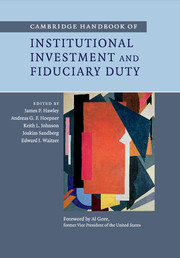Book contents
- Frontmatter
- Contents
- List of figures
- List of tables
- List of contributors
- Foreword
- 1 Introduction
- Part I Fiduciary duty: a global outlook
- Part II Fiduciary duty and the landscape of institutional investment
- 8 The philanthropic fiduciary: challenges for nonprofits, foundations and endowments
- 9 Paradigm lost: employment-based defined benefit plans and the current understanding of fiduciary duty
- 10 Economically targeted investing: changing of the guard
- 11 Institutional investment in the European Union Emissions Trading Scheme
- 12 Have institutional fiduciaries improved securities class actions? A review of the empirical literature on the PSLRA’s lead plaintiff provision
- 13 The future of fiduciary obligation for institutional investors
- Part III Challenging conventional wisdom on fiduciary duty
- Part IV Towards a broader interpretation of fiduciary duty
- Part V Beneficiaries’ roles and viewpoints
- Part VI Fiduciary duty and governance
- Index
- References
13 - The future of fiduciary obligation for institutional investors
Published online by Cambridge University Press: 05 April 2014
- Frontmatter
- Contents
- List of figures
- List of tables
- List of contributors
- Foreword
- 1 Introduction
- Part I Fiduciary duty: a global outlook
- Part II Fiduciary duty and the landscape of institutional investment
- 8 The philanthropic fiduciary: challenges for nonprofits, foundations and endowments
- 9 Paradigm lost: employment-based defined benefit plans and the current understanding of fiduciary duty
- 10 Economically targeted investing: changing of the guard
- 11 Institutional investment in the European Union Emissions Trading Scheme
- 12 Have institutional fiduciaries improved securities class actions? A review of the empirical literature on the PSLRA’s lead plaintiff provision
- 13 The future of fiduciary obligation for institutional investors
- Part III Challenging conventional wisdom on fiduciary duty
- Part IV Towards a broader interpretation of fiduciary duty
- Part V Beneficiaries’ roles and viewpoints
- Part VI Fiduciary duty and governance
- Index
- References
Summary
Introduction
The context of this chapter is one of change. The world of institutional investment has been undergoing some fundamental structural shifts for a number of years, and many of these have direct implications for the future of fiduciary obligation.
The defined benefit pension fund, once the mainstay of institutional investment funds, is quickly being replaced by the defined contribution scheme. This transfers the risk of poor investment performance from corporate and state employers to individual beneficiaries. At the same time, pension fund trustees, the traditional bearers of fiduciary obligation, are now rarely the key players in investment decision-making. Virtually all asset owners have delegated day-to-day investment decision-making to asset managers and strategic planning to investment consultants, and whether these agents are bound by fiduciary obligation is often unclear. Finally, trust-based pension funds are increasingly giving way to contract-based schemes operated by large insurance companies. These are governed by the law of contracts, under which fiduciary obligation does not exist.
- Type
- Chapter
- Information
- Publisher: Cambridge University PressPrint publication year: 2014
References
- 1
- Cited by



